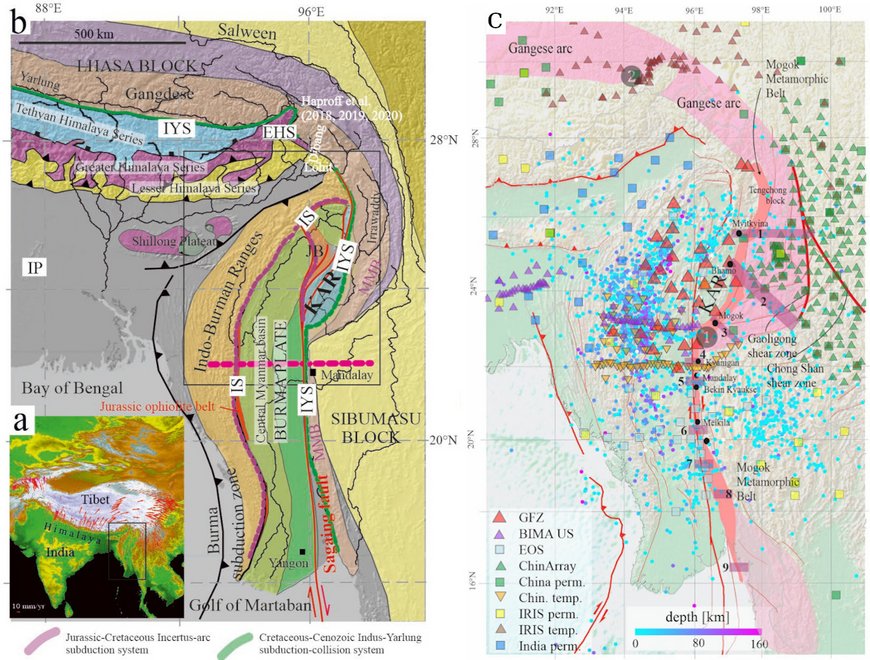CoSuMY: Collision-Subduction Transition in Myanmar-Yunnan
Indenter corners in collision zones are fascinating features in continental tectonics. There, deformation is truly 3D, involving crustal thickening, lateral material flow, and transition from continental to oceanic subduction. The latter transition is important for nucleating slab-dynamic processes: differences in buoyancy between oceanic and continental lithosphere may, for example, trigger slab tearing and breakoff. These mantle processes affect the force balance and hence deformation in the crust. The eastern Himalaya syntaxis region, encompassing Myanmar, China, and India, is a perfect natural laboratory to study these processes. Myanmar lies along the obliquely subducting/colliding eastern margin of the Indian plate. The Burma microplate is the hanging wall of the Burma-Andaman subduction zone, bounded in the east by the plate-bounding dextral Sagaing transform fault zone along the margin of the Asian plate. We aim to study (1) where the continental collision to oceanic subduction transition is today and how it influences lower and upper plate deformation and mantle wedge processes, and (2) where the continental collision-oceanic subduction transition was in the past; this also addresses how far the eastern tip of the continent-continent collision zone has moved around the eastern Himalaya syntaxis and when the Sagaing fault system and associated transform structures in the hanging Asian plate were formed. Finally, we aim to study for the present and since the Eocene (3) which role mantle processes—slab retreat and breakoff—have played in shaping the crustal structure and deformation. To reach these goals we propose to combine tectonics and seismology in order to constrain the current lithospheric structure and the stress field alongside the tectonic history of the hanging wall indicative of its dynamic past. For this purpose, we were operating a 30-station seismic network in northern Myanmar, which we will complement with additional temporary and permanent seismic networks in Myanmar, India and China. This allows us to map seismicity and earthquake source parameters and hence deformation at unprecedented detail. We will derive a lithospheric-scale tomographic model of the syntaxis region to characterize the crust and mantle structure. We will apply structural geologic, petrologic, and petro-geo-thermochronologic methods to analyze data and samples collected during two completed field seasons to reconstruct the pressure-temperature-deformation-time evolution of key regions in the hanging Asian plate. With our extensive preparatory work, we demonstrated that we can successfully execute the project despite the severe restrictions imposed by the current political situation in Myanmar.

Time frame
- 2023 - 2026
Principal Investigator
- Frederik Tilman (GFZ)
- Xiaohui Yuan (GFZ)
- Bernd Schurr (GFZ)
Funding
- DFG
Cooperation/Partner
- Lothar Ratschbacher (Uni Freiberg)
- Sofia Kufner (KIT)
- Oo Than (DMH, Myanmar)
- Eric Sandvol (University of Missouri, USA)
- Shenji Wei (EOS, Singapore)
- Supryo Mitra (IISER Kolkata, India)
- Zhouchuan Huang (Nanjing University, China)
Research Unit(s) (POF/MESI/GIPP)




